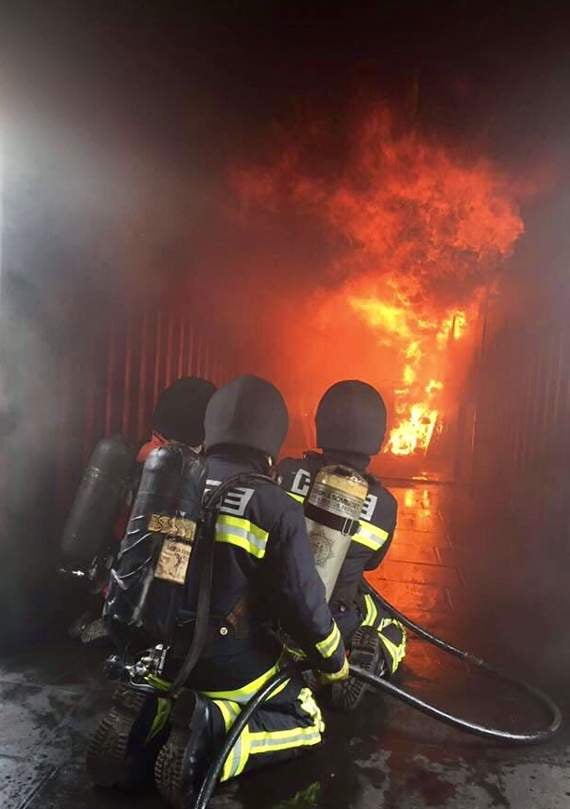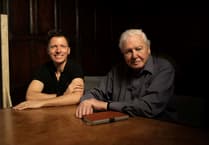Local fire stations are calling for new recruits so I went along to a training day in Exeter to find out what they go through.
When I arrived, I met up with Neil Willmott, the station manager at Plympton. He’d sorted me out a set of new overalls, boots and helmet, and after a bit of searching around, a tabard with ‘observer’ written on it so no one asked me any questions I wouldn’t have a clue how to answer if we went on a ‘shout’.
From there we were off to the Fire Behaviour Training Centre at Exeter Airport. As well as myself, there were fire crews being taken through their re-qualifications and one team of new recruits going through the training for the first time.
When we arrived at Exeter I met Matt Radford, station manager at Plympton, who, with Neil, would take me around the training facility and make sure I didn’t injure myself (or anyone else).
The training I got to watch - and later have a go at - was the BA, Breathing Apparatus, Training. At the Exeter Airport training site, there are four or five large shipping containers adapted for teaching how to use a ‘branch’ (hose) and fight a fire that is tightly controlled within the container.
First off was getting fitted with a Breathing Apparatus. For anyone who has ever scuba dived, it’s pretty similar, apart from the fact that mask and air regulator is one unit that goes completely over the face and the back of your head.
Unlike if you’re scuba diving and the weight is lifted off you in the water, the tank is heavy. Not fall-over-backwards heavy, but you definitely know you’re wearing it!
Once I was kitted out with trousers and a tunic, boots, a fire-proof balaclava, helmet and breathing apparatus I was ready to go.
The teams going through their training were working in pairs, as firefighters always do. The fire is set in the end of the container and trainees need to open the door and make their way through the container to the fire.
Visibility in those containers is low. Smoke and gases are thick - the fires are burnt with off cuts of wood and plyboard - and the ‘neutral plane’ - where the clean air is below and the smoke and gases are above, means you have to almost rest your helmet on the floor to be able to see in front of you.
I was very lucky to be able to sit at the back of the containers and watch a couple of teams go through their exercises. Simon Wonnacott, the BA trainer and watch manager in charge at Ivybridge, takes the crews through their training and re-qualifications.
He is calm and composed, just what you need from someone teaching you something dangerous, and hearing him go through the movements and exercises with the crews is a great experience. There is no yelling or frustration when things go wrong, just a cool explanation and try again.
This was especially evident when one of the crews puts too much water on the fire and created a huge amount of steam. Everyone is cleared out of the container and instructors move in to slosh most of the water out of the side door and when everything is back to normal, they go again.
‘Branch skills’ are very different to anything you’ve seen in the films, where generally they just blast a fire with a powerful hose until it’s out.
The first thing you have to do is point the hose directly above you and create a wide shower of water above your head. This cools the area around you and your partner and puts tiny droplets of water into the air, preventing gases and smoke from igniting above you.
Then you use ‘painting’, low pressure water used to actually put the fire out. Too much pressure and too much water and you create a lot of steam, which not only lowers your visibility - considerably, it took me by surprise - but also increases the temperature in the area and can cause steam burns.
All the instructors are friendly and professional, with the perfect balance of being able to take the mick and command respect and concentration from those they are training. It comes across as a very ‘work hard, play hard’ atmosphere, and I’ve come to the conclusion that most firefighters are slightly bonkers.
The training consists of 12 days of Core Skills, ten days of BA Training split over two weeks and three days of road traffic collision training.
Its not just fires that the Devon and Somerset Fire and Rescue Service are called out to. Rescuing people trapped in lifts, small children who have locked themselves in bathrooms or cars, helping cut people from car crashes, in fact generally rescuing people from all sorts of situations. They also respond to animal rescues, flooding and chemical spills.
Due to improved and targeted fire safety activities, most of the crews at small rural fire stations won’t fight a fire between one qualification and the next, but when they’re called upon, they have the skills to save lives in what must be the scariest situation a person can find themselves in.
Another plus is that becoming a retained fire fighter is not a volunteer position, you do get paid.
For Kingsbridge and Modbury stations, you receive a salary of just over £5,000 a year as a trainee on call for 84 hours a week, rising to more than £6,600 as you become more experienced. For 63 hours a week, you receive just over £4,000 a year as a trainee, rising to more than £5,300 with experience.
Salcombe station work on a slightly different system, where they are given a £2,000 retainer and then are given a payment for drill nights and call outs.
There is one two-hour drill night a week, but apart from that you’re just on call, ready to respond to any call that comes in. Kingsbridge Station gets around 150-200 calls a year, Salcombe between 50 and 60 and Modbury around 100, but whether you’re on call during those times is down to luck.
It was a shame I didn’t get a chance to go out on a shout with any of the crews, but this is mostly the life of on-call fire fighters - days or weeks of not much and then it all happens at once.
In their bid to attract more retained fire fighters, DSFRS are becoming more flexible with on-call availability. You need to live or work (depending on whether you can be on call during the day or in the evening) within five-ish minutes of the station.
Employers need to be able to allow you to take off as soon as you receive a call, which can be difficult for certain careers, but employers who release their staff for retained fire fighting duties get great PR for their company. If employees have the commitment to be a retained fire fighter, they’re likely to be committed workers too, and they bring back transferable skills to the workplace.
In Kingsbridge, Quay Auto and Herring Shoes both release staff to be retained fire fighters. Kingsbridge, Salcombe, Modbury, Kingston, Totnes and Plympton stations are all currently looking to recruit.
If you’re self employed, DSFRS have a new online system, meaning you can book yourself off if, say, you have a job for an hour outside the area, and book yourself back on when you return. Parents of young children, who have time during the day, can be booked off for school runs, for example.
Firefighters can see some harrowing things, alongside all our emergency services, they’re never quite sure what to expect when they get to a call. But the support is there, nowadays all firefighters are fully de-briefed and offered counselling if they want it, to prevent any possible mental health issues from developing years along the line.
Women are also encouraged to apply, anyone can be a firefighter. The only prerequisites are you have to be over the age of 18, a good level of fitness, work well under pressure and with good communication skills. That’s it. Everything else is taught by an expert team and you get to be a part of a team of local heroes.
You can also take some steps at home to make your family safer. DSFRS offers free Home Fire Safety Checks. The check takes no longer than five minutes, after which you may be offered a home fire safety visit. The visit takes less than 30 minutes, they provide advice and fit a free smoke detector if required. If you would like a free home fire safety check, call 0800 05 02 999.
Thank you to Neil, Matt and Simon who made sure I had a great experience with the DSFRS and if anyone is considering applying to be a retained fire-fighter for their local station, visit the website: www.dsfire.gov.uk and click on Working For Us, you couldn’t ask for a nicer group of people to work with.

.jpeg?width=209&height=140&crop=209:145,smart&quality=75)



Comments
This article has no comments yet. Be the first to leave a comment.